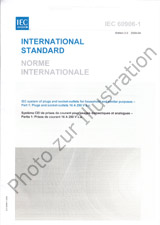Wir benötigen Ihre Einwilligung zur Verwendung der einzelnen Daten, damit Sie unter anderem Informationen zu Ihren Interessen einsehen können. Klicken Sie auf "OK", um Ihre Zustimmung zu erteilen.

IEC 60512-28-100-ed.3.0
Connectors for electrical and electronic equipment - Tests and measurements - Part 28-100: Signal integrity tests up to 2 000 MHz - Tests 28a to 28g
Name übersetzen
NORM herausgegeben am 2.8.2024
Informationen über die Norm:
Bezeichnung normen: IEC 60512-28-100-ed.3.0
Ausgabedatum normen: 2.8.2024
SKU: NS-1194484
Zahl der Seiten: 97
Gewicht ca.: 322 g (0.71 Pfund)
Land: Internationale technische Norm
Kategorie: Technische Normen IEC
Kategorie - ähnliche Normen:
Die Annotation des Normtextes IEC 60512-28-100-ed.3.0 :
IEC 60512-28-100:2024 specifies the test methods for signal integrity and transmission performance for connectors specified in respective parts of IEC 60603-7, IEC61076-1, IEC 61076-2, IEC 61076-3 and IEC 63171 series of standards for connecting hardware applications from 0,1 MHz up to 2 000 MHz, with reference to this document. Note: This document is also suitable for testing signal integrity and transmission performance of connectors up to a lower value of maximum frequency; however, the test methodology specified in the detail specification for any given connector remains the reference conformance test for that connector. The list of connector series of standards does not preclude referencing this document in other connector manufacturer’s specifications or published standards. Test procedures provided herein are: - insertion loss, test 28a; - return loss, test 28b; - near-end crosstalk (NEXT) test 28c; - far-end crosstalk (FEXT), test 28d; - transverse conversion loss (TCL), test 28f; - transverse conversion transfer loss (TCTL), test 28g. Other test procedures referenced herein are: - shield transfer impedance (ZT), see IEC 60512-26-100, test 26e. - coupling attenuation (aC), see IEC 62153-4-7 and IEC 62153-4-12. - low frequency coupling attenuation (aCLF) see IEC 62153-4-7 and IEC 62153-4-15 This edition includes the following significant technical changes with respect to the previous edition: -The frequency range has been modified to start at 0,1 MHz instead of 1 MHz, to include single-pair connectors. -All tables and requirements have been revised down to 0,1 MHz, and partially improved to reduce the impact of the test fixture. -Formulae to calculate the S-parameters from single-ended parameters have been added. -A note was added for those parameters which are not applicable to single-pair connectors. LIEC 60512-28-100:2024 specifie les methodes d’essai pour l’integrite du signal et les performances de transmission pour les connecteurs specifies dans les parties respectives de lIEC 60603-7, lIEC 61076-1, lIEC 61076-2, lIEC 61076-3 et de la serie de normes IEC 63171 pour connecter les applications materielles de 0,1 MHz a 2 000 MHz, en reference au present document. NOTE Le present document convient egalement pour soumettre a essai l’integrite des signaux et les performances de transmission des connecteurs jusqu’a une valeur inferieure de frequence maximale; toutefois, la methodologie d’essai specifiee dans la specification particuliere pour un connecteur donne reste l’essai de conformite de reference pour ce connecteur. La liste de series de normes concernant les connecteurs n’exclut pas le fait de faire reference au present document dans d’autres normes publiees ou specifications des fabricants de connecteurs. Les procedures d’essai specifiees ici sont les suivantes: - perte d’insertion, essai 28a; - affaiblissement de reflexion, essai 28b; - paradiaphonie (NEXT), essai 28c; - telediaphonie (FEXT), essai 28d; - perte de conversion transverse (TCL), essai 28f; - perte de transfert de conversion transverse (TCTL), essai 28g. Les autres procedures d’essai citees ici en reference sont: - impedance de transfert, (ZT), voir l’IEC 60512-26-100, essai 26e; - affaiblissement de couplage (aC), voir l’IEC 62153-4-7 et l’IEC 62153-4-12; - affaiblissement de couplage basse frequence (aCLF), voir l’IEC 62153-4-7 et l’IEC 62153-4-15.
Empfehlungen:
Aktualisierung der technischen Normen
Wollen Sie sich sicher sein, dass Sie nur die gültigen technischen Normen verwenden?
Wir bieten Ihnen eine Lösung, die Ihnen eine Monatsübersicht über die Aktualität der von Ihnen angewandten Normen sicher stellt.
Brauchen Sie mehr Informationen? Sehen Sie sich diese Seite an.



 Cookies
Cookies
